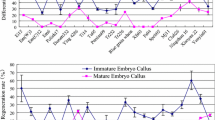Summary
The aim of the investigations was to identify and select the starting material capable of producing differentiated callus and well-growing suspension cultures from immature embryos and inflorescences. The cultivars have been ranked in order of decreasing ability for callus induction on the basis of callus mass. The ability for callus differentiation has been also compared, based upon intensity of the process. Finally, the number of regenerated plants was recorded. All expiants of both immature embryos and inflorescences of the examined cultivars were capable of callus induction. However, the genotypic differences were statistically significant. The greatest mass of callus/embryo was obtained from the cvs. Sakwa, Olcha, Kobra and Almari, and the smallest from the cvs. Korweta and Emika. The greatest mass of callus/inflorescence was obtained from the cvs. Kaja and Zorza. The most intensive callus differentiation was observed from cvs. Almari, Emika, Sakwa and Korweta. Cvs. Tercja and Maltanka regenerated the greatest number of plants per gram of callus. Some tissues were maintained for a long-term culture. The growth index (GI) of callus in successive transfers has also been determined. Suspension cultures from calli both of immature embryo and inflorescence origin of cv. Kaja have been initiated. The growth kinetics of these suspensions was evaluated on the basis of settled and packed cell volume, fresh and dry mass during 17 days of culture. Increase of these parameters was similar for both expiants showing that they are equally good sources of the suspension culture.
Similar content being viewed by others
References
Borelli G. M., Lupotto E., Locatelli F., Wittmer G., 1991. Long-term optimized embryogenic cultures in durum wheat (Triticum durum Desf). Plant Cell Rep., 10: 296–299
Castillo A. M., Egana B., Sanz J. M., Cistue L., 1998. Somatic embryogenesis and plant regeneration from barley cultivars in Spain. Plant Cell Rep., 17: 902–906
Felfoldi K., Purnhauser L., 1992. Induction of regenerating callus cultures from immature embryos of 44 wheat and 3 triticale cultivars. Cereal Res. Comm., 20: 273–277
Fellers J.P., Guenzi A.C., Taliaferro C.M., 1995. Factors affecting the establishment and maintenance of embryogenic callus and suspension cultures of wheat (Triticum aestivum L). Plant Cell Rep., 232–237
Galiba G. and Yamada Y., 1998. A novel method for increasing the frequency of somatic embryogenesis in wheat tissue culture by NaCl and KCl supplementation. Plant Cell Rep., 7: 55–58
Gana J.A, Sharma G.C., Zipf A., Saha A, Roberts J., Wesenberg D.M., 1995. Genotype effects on plant regeneration in callus and suspension cultures of Avena. Plant Cell, Tissue and Organ Culture, 40: 217–224
Li Z., Xia G., Chen H., 1992. Somatic embryogenesis and plant regeneration from protoplasts isolated from embryogenic cell suspensions of wheat (Triticum aestivum L.) Plant Cell, Tissue and Organ Culture, 28, 79–85
Machii H., Mizuno H., Hirabayashi T., Li H, Hagio T., 1998. Screening wheat genetypes for high callus induction and regeneration capability from anther and immature embryo cultures. Plant, Cell, Tissue and Organ Culture, 53: 67–74
MacKinnon C., Gunderson G., Nabors M., 1987. High efficiency plant regeneration by somatic embryogenesis from callus of mature embryo expiants of bread wheat (Triticum aestivum) and grain sorghum (Sorghum bicolor), In vitro Cell. J. Dev. Biol., 23: 443–448
Maddock S.E., Lancaster V.A., Rissiot R, and Franklin J., 1983. Plant regeneration from cultured immature embryos and inflorescences of 25 cultivars of wheat (Triticum aestivum L.). J. Exp. Bot., 34: 915–926
Marcińska I., Dubert F., Biesaga-Kościelniak J., 1995. Transfer the ability to flower in winter wheat via callus tissue regenerated from immature inflorescences. Plant Cell, Tissue and Organ Culture, 41, 285–288
Marcinska I., Dubert F., Biesaga-Kościelniak., 1996. DeWzrost i różnicowanie kalusa pszenicy ozimej pod wprywem stresu niskiej temperatury i 2,4-D. W: Grzesiak S., Miszalski Z. (red.) “Ekofizjologiczne aspekty reakcji roślin na działanie abiotycznych czynników stresowych”. ZFR PAN, Kraków, 369–378
Menke-Milczarek I., Zimny J., 1992. The efficiency of somatic embryogenesis of wheat (Triticum aestivum L.). II. Embryogenie response of immature embryo depending on genotype and medium. Bull, of Pol. Acad, of Sci, 40 (3), 189–195
Ozgen M, Turet M, Altinok S., Sancak C., 1998. Efficient callus induction and plant regeneration from mature embryo culture of winter wheat (Triticum aestivum L.) genotypes. Plant Cell Rep, 18: 331–335
Ozias-Akins P., Vasil I.K., 1982. Plant regeneration from cultured immature embryos and inflorescences of Triticum aestivum L. (Wheat): Evidence for somatic embryogenesis, Protoplasma, 110: 95–105
Ozias-Akins P, Vasil I.K, 1983. Improved efficiency and normalization of somatic embryogenesis in Triticum aestivum (wheat). Protoplasma, 117, 40–44
Pauk J, Kertesz Z, Jenes B, Purnhauser L, Manninen O, Pulli S, Barabas Z, Dudits D., 1994. Fertile wheat (Triticum aestivum L.) regenerants from protoplasts of embryogenic suspension culture. Plant Cell, Tissue and Organ Culture, 38, 1–10
Rakoczy-Trojanowska M. and Malepszy S., 1993. Genetic factors influencing regeneration ability in rye (Secale cereale L.). I. Immature inflorescences. Theor. Appl. Genet, 86: 406–410
Zenkteler A., 1984. Plant cell and tissue culture (In Polish), ISBN 83-01-04944-8, pp 480
Author information
Authors and Affiliations
Corresponding author
Rights and permissions
About this article
Cite this article
Marcińska, I., Szechyńska, M., Biesaga-Kościelniak, J. et al. Applicability of Polish Winter Wheat (Triticum aestivum L.) Cultivars to Long-Term in vitro Culture. CEREAL RESEARCH COMMUNICATIONS 29, 127–134 (2001). https://doi.org/10.1007/BF03543652
Received:
Accepted:
Published:
Issue Date:
DOI: https://doi.org/10.1007/BF03543652




